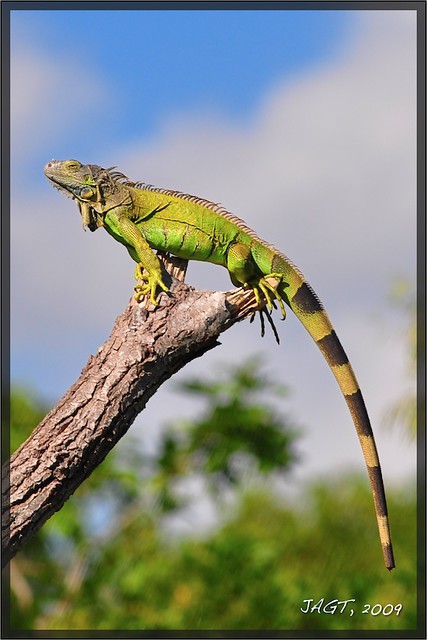Green Iguana
Order: Squamata
Family: Iguanidae
Scientific Name: Iguana iguana
 Description: The green iguana is a large (5-7ft) lizard that can
weigh up to 18lbs. Its body is covered
with soft leathery scales, and has a dorsal crest of spines that descend in
size from their starting point, at the base of the head, to their ending point,
the tip of the tail. They typically start life as a bright green color, but it
fades to a more grayish-green with age. However, the
green iguana is capable of slightly altering their color due to their
moods, social interactions, or environmental conditions, so the colors will
vary. The green iguana is typically an arboreal lizard
so it has characteristically short legs with feet that have five very long toes
with sharp claws. It also has a long, whip-like
tail, which helps with balance when climbing and allows for easy swimming; the
tail is also used as a weapon or can be broken when as a "get-away" strategy. The green iguana can be distinguished from
other iguanas based on the hanging dewlap found under their throat, the dorsal
crest down the middle of their back, large scales on each side of the head, variably
ringed-tails, and a membrane-covered tympanum.
Description: The green iguana is a large (5-7ft) lizard that can
weigh up to 18lbs. Its body is covered
with soft leathery scales, and has a dorsal crest of spines that descend in
size from their starting point, at the base of the head, to their ending point,
the tip of the tail. They typically start life as a bright green color, but it
fades to a more grayish-green with age. However, the
green iguana is capable of slightly altering their color due to their
moods, social interactions, or environmental conditions, so the colors will
vary. The green iguana is typically an arboreal lizard
so it has characteristically short legs with feet that have five very long toes
with sharp claws. It also has a long, whip-like
tail, which helps with balance when climbing and allows for easy swimming; the
tail is also used as a weapon or can be broken when as a "get-away" strategy. The green iguana can be distinguished from
other iguanas based on the hanging dewlap found under their throat, the dorsal
crest down the middle of their back, large scales on each side of the head, variably
ringed-tails, and a membrane-covered tympanum.
Habitat and Distribution: Green iguanas are naturally distributed
from south Mexico to the northern parts of South America, including the Lesser
Antilles islands. They have also been
introduced to Florida and Hawaii due exotic pet trade.
The green iguana is commonly found in tropical rainforest trees, as
high as 1,000 meters. Although mostly
arboreal, they are also terrestrial. They
typically avoid the deep forests, so as to have plenty of sunlight for exothermic
processes and for egg incubation on the ground.
Though it is possible to find them in open areas where there are plenty
of resources, they are most commonly found where the tree-line meets water, as
they are known to swim, like the one I spotted in Key Largo. Although s/he swam away before I could snap a
picture, s/he looked something like this in the water:
Diet: The green iguana is
an herbivore. They prefer to eat leaves,
flowers, fruits, and other plant material, but bird nestlings and eggs are also
known to be eaten. While green iguanas
are young, they require a lot of protein for growth, so they will eat mostly insects,
but they too will eat other animal matter, such as adult iguana droppings.
Reproduction: Typically correlated with rainfall, the
reproductive season occurs in the first part of the dry season in fall. The males will perform color and behavioral
displays, which can include dewlap extensions, head-bobbing, and pushups. The females will choose the males with impressive
displays. During the mating process, the
male will bite the female to line up their cloacas so he can use his hemipenis deposit
his sperm within the female. The female
will then carry the eggs for about 2 months.
The eggs are laid toward the end of the dry season, in clutch sizes from
12 to 40. The eggs hatch into one foot,
bright green, juvenile iguanas after about 90 days, which is during the wet
season, and they will mature after about 3 years.
Longevity and Conservation status: In the wild, green iguanas typically live
about 8 years, but in captivity they can live up to 20 years. Although the green iguana is not considered a
threatened, CITES lists them so as to maintain the natural populations. Green iguanas are known in their natural habitats
as “the chicken of the trees” due to their tasty meat. As a result, their main predator is humans, who overharvest the iguanas for their
tasty meat, as well as, for their skin to make leather products, and their eggs
for pet trade.
Personal Experience: I
encountered my first green iguana in the gravel driveway of my hotel in Key
Largo. S/he was at the base of a tree
line basking in the sun. The moment I
took a slight step in its direction, it was gone. The second time I spotted a green iguana was
also in Key Largo, on a hot day. I know
it was hot because the iguana was sitting on a patch of seaweed and algae in
the Bay’s brackish water near a patch of pushes, as shown and stated above. S/he sat there for a long time until some
people came up behind me making a lot of noise, which caused it to swim down in
water.


For more information:


1 comment:
Thank you, Jessica. Chicken of the trees...sigh! Must have been very exciting to see them and they must have been pretty common if you were seeing them near your hotel. Very cool.
Post a Comment